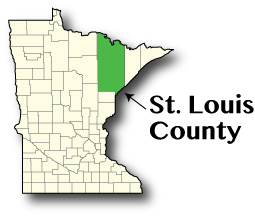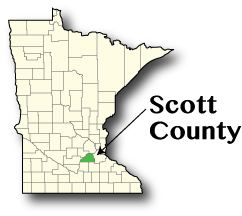by Erik White
September 2018

Named after the St. Louis River that flows through the county's southeast corner, St. Louis County was established in 1856. Much of the county's population has a link to the mining, timber, and shipping industry. Mining is of considerable importance to the county and the country, as it's been said that the United States couldn't have won WWII without the ore mined on the Iron Range and the shipbuilding at the shipyards in Duluth-Superior Harbor. Even today 85 percent of the country's domestic iron is produced by the area's iron mines.
While population and workforce growth has been flat for some time, the labor force is expected to decline by 5.6 percent by 2030. This decline could have a long-lasting impact if investments by existing or new companies are curtailed by a lack of workers. Nevertheless, employers in the county have managed to expand payrolls since the recession ended and by 2015 had fully regained the number of jobs lost. Despite little or no labor force growth, the economy continues to add jobs and shows no signs of stopping.
Since peaking in 1960, the population of the county has been consistent since 1990 at roughly 200,000 residents. Much like the population, the labor force has also remained stable, after growing from 94,000 workers in 1990 to 100,000 by 1995. The number of available workers in 2017 was roughly 102,000. Unemployment rates have fallen in recent years after peaking at 9.1 percent during the recession. The rate fell to 4.8 percent in 2017, just slightly higher than historic norms for an expanding business cycle.
The highly concentrated Health Care and Social Assistance industry provides more than a quarter of all jobs in the county, easily the largest employing industry. Average annual wages in the Health Care industry are also unusually high, at just over than $50,000 per year, which was much higher than the average for all jobs in the county ($44,460). Retail Trade is the second largest industry with about 12,000 jobs at 843 business establishments.
Mining, while synonymous with the iron range, is the 11th largest industry, but the second highest paying industry. Its 3,279 jobs provide an average annual wage of more than $88,000 per year, double the average for the overall economy in the county.
| Economy | ||
|---|---|---|
| 2017 Estimates | St. Louis County | Minnesota |
| Population | 200,000 | 5,576,606 |
| Labor Force | 101,991 | 3,063,604 |
| Average Unemployment | 4.8% | 3.60% |
| Median Household Income (2016) | $49,395 | $63,217 |
| Cost of Living, Individual | $27,575 | $31,656 |
| Cost of Living, Average Family | $47,076 | $57,624 |
| Source: U.S. Census Bureau, DEED LAUS, American Community Survey, DEED COL | ||
| Industry | |||||
|---|---|---|---|---|---|
| Top Employing Industries | 2017 | 2012-2017 | |||
| Number of Firms | Number of Jobs | Average Wage | Change in Jobs | Change in Wages | |
| Total, All Industries | 5,260 | 98,009 | $44,564 | 4,576 | $4,784 |
| Trade, Transportation, and Utilities | 1,218 | 17,932 | $36,972 | 606 | $3,744 |
| Leisure and Hospitality | 688 | 11,984 | $17,264 | 758 | $3,224 |
| Educational and Health Services | 749 | 33,932 | $48,828 | 1,225 | $6,344 |
| Manufacturing | 213 | 4,471 | $53,820 | -146 | $3,484 |
| Source: DEED's Quarterly Census of Employment and Wages | |||||

Scott County, located southwest of the Twin-Cities and inner-ring suburbs, was established in 1853 and named in honor of General Winfield Scott. The county is home to the Shakopee-Mdewakanton Indian Reservation and Mystic Lake Casino. The area of Scott County, as well as much of southern Minnesota, was opened for settlement by the Mendota and Traverse des Sioux treaties in the early 1850s, which resulted in removing and placing Dakota Indians on reservations in northern Minnesota and opening lands to European settlers who utilized the Minnesota River and ox cart trails for fur trading, lumbering, and farming.
With the continued development of the exurbs, Scott County is projected to increase its population significantly over the next 20 years. By 2040 the county's population is projected to be 187,905, an increase of 35,000 residents and a 22.9 percent growth rate over the 20 year period. Unlike other areas of the state that are affected by stagnate population growth and an aging population, Scott County is expected to grow its labor force over the next decade, with an estimated increase of 4,000 potential workers between the ages of 25 to 44.
The population in the county has experienced a 63 percent growth rate since 2000, with an increase of 56,329 people, making it the fastest growing county in the state. This population increase has also resulted in an increase of nearly 20,000 people to the county's labor force in the same time frame. With its proximity to the Twin-Cities, the county is an exporter of labor, with 53,196 people living in the county but working outside the county boundary and only 23,274 people coming in from outside the county to work within Scott County. Meanwhile, 16,156 people work and reside in the county.
Trade, Transportation, and Utilities is the leading supersector of employment with nearly 14,000 jobs and 619 firms. The Manufacturing sector in the county has gained 1,611 jobs since 2012, and now employs 6,386 people with an average annual wage of $76,596. This wage is $28,500 more than the annual average wage for all industries in the county and highlights the importance of this sector to the county's economy
| Economy | ||
|---|---|---|
| 2017 Estimates | Scott County | Minnesota |
| Population | 145,827 | 5,576,606 |
| Labor Force | 81,154 | 3,063,604 |
| Average Unemployment | 3.0% | 3.6% |
| Median Household Income (2016) | $90,198 | $63,217 |
| Cost of Living, Individual | $34,170 | $31,656 |
| Cost of Living, Average Family | $61,422 | $57,624 |
| Source: U.S. Census Bureau, DEED LAUS, American Community Survey, DEED COL | ||
| Industry | |||||
|---|---|---|---|---|---|
| Top Employing Industries | 2017 | 2012-2017 | |||
| Number of Firms | Number of Jobs | Average Wage | Change in Jobs | Change in Wages | |
| Total, All Industries | 3,102 | 53,163 | $48,048 | 11,449 | $4,732 |
| Trade, Transportation, and Utilities | 619 | 13,939 | $39,988 | 6,384 | $2,340 |
| Leisure and Hospitality | 286 | 9,071 | $28,756 | -275 | $3,796 |
| Educational and Health Services | 302 | 8,556 | $46,800 | 651 | $6,292 |
| Manufacturing | 176 | 6,386 | $76,596 | 1,611 | $15,964 |
| Source: DEED's Quarterly Census of Employment and Wages | |||||

Located in central Minnesota, between the Twin-Cities and St. Cloud, Sherburne County was established in 1856 with Elk River designated as its county seat. By 1870 there were 2,050 residents in the county with much of the commerce in the county utilizing the ox cart trails and the Mississippi River, which creates the county's southern border. With the introduction of railroads came population increases and increased economic activity with population expanding to nearly 8,000 by the turn of the 20th century and population stability through the 1950s.
Despite considerable recent population growth, the county is expected to slow down in gaining new residents. Based on population projections from the Minnesota State Demographic Center, the population is expected to surpass 101,000 people by 2040, a 7.2 percent growth rate—which is much less than the 22.1 percent growth rate experienced in the county since 2000. While the population grows, the labor force is expected to remain stable as an aging population retires from the workforce. However, an increase of 1,370 people in the labor force between the ages of 25 and 44 is projected, helping replace those retirees in the county.
Again, because of its proximity to the Twin Cities and the development of exurbs, Sherburne County was the third fastest growing county in Minnesota. Since 2000 it has added 30,153 residents, a 46.8 percent increase, and now has 94,570 residents. This population increase resulted in an increase of 9,157 people in its labor force since 2002, a 22.1 percent increase, substantially more than the 7.1 percent increase to the labor force that the state of Minnesota experienced during that time.
Trade, Transportation, and Utilities was the leading supersector in the county's economy with 347 businesses providing 6,061 covered jobs in the county with an annual average wage of $43,836. There had been a gain of 2,394 jobs in the county since 2012 with Manufacturing adding 765 jobs with an average annual wage of $56,784, substantially more than the average annual wage for all industries. However, the Educational and Health Services sector recorded a decrease of nearly 500 jobs since 2012 but still has about 23 percent of all jobs in the county.
| Economy | ||
|---|---|---|
| 2017 Estimates | Sherburne County | Minnesota |
| Population | 94,570 | 5,576,606 |
| Labor Force | 50,681 | 3,063,604 |
| Average Unemployment | 3.9% | 3.6% |
| Median Household Income (2016) | $78,081 | $63,217 |
| Cost of Living, Individual | $35,965 | $31,656 |
| Cost of Living, Average Family | $62,184 | $57,624 |
| Source: U.S. Census Bureau, DEED LAUS, American Community Survey, DEED COL | ||
| Industry | |||||
|---|---|---|---|---|---|
| Top Employing Industries | 2017 | 2012-2017 | |||
| Number of Firms | Number of Jobs | Average Wage | Change in Jobs | Change in Wages | |
| Total, All Industries | 1,932 | 25,601 | $43,836 | 2,394 | $4,784 |
| Trade, Transportation, and Utilities | 347 | 6,061 | $45,136 | 546 | $3,484 |
| Educational and Health Services | 202 | 5,871 | $42,796 | -483 | $6,656 |
| Manufacturing | 149 | 3,702 | $56,784 | 765 | $5,408 |
| Leisure and Hospitality | 152 | 2,338 | $14,508 | 311 | $3,016 |
| Source: DEED's Quarterly Census of Employment and Wages | |||||

Sibley County was named after Henry Hastings Sibley, the first governor of Minnesota and established in 1853. Despite being a part of the Minneapolis and St. Paul Metropolitan Statistical Area, the county has a much smaller population base with only 14,869 residents. The population in the county has remained remarkably consistent as it had 15,199 residents in 1890 and has never surpassed 17,000 people.
Much like the historical population trend, the future population is projected to remain stable. With a slight decrease in residents by 2040 it is projected to have only 13,831 people. Unlike other counties in the Twin Cities MSA, population increases are not expected which will limit the potential for an economic expansion in the county. However, the cost of living in the county is lower than the state average with a yearly salary of $29,145 needed to match the basic needs budget for an individual and a family income of $49,421 needed to provide for the basic needs of an average family - two wage earners, 1 full-time, 1 part-time, with one child. This relatively low cost of living could be attractive to those living in higher cost-of- living areas in the metro and help to increase the population of Sibley County and build the economic base of the county.
There are 4,409 jobs in Sibley County and 391 firms. The leading supersector of employment is Educational and Health Services with 1,025 jobs, nearly 25 percent of all employment in the county. Since 2012 the county has lost 158 jobs. From its proximity to Minneapolis and its suburbs, the county is an exporter of labor with nearly 5,000 people living in the county but working elsewhere. Only 1,840 people work in the county who live elsewhere. Meanwhile, 2,143 people live and work in Sibley County.
| Economy | ||
|---|---|---|
| 2017 Estimates | Sibley County | Minnesota |
| Population | 14,869 | 5,576,606 |
| Labor Force | 8,533 | 3,063,604 |
| Average Unemployment | 3.7% | 3.6% |
| Median Household Income (2016) | $59,596 | $63,217 |
| Cost of Living, Individual | $29,145 | $31,656 |
| Cost of Living, Average Family | $49,421 | $57,624 |
| Source: U.S. Census Bureau, DEED LAUS, American Community Survey, DEED COL | ||
| Industry | |||||
|---|---|---|---|---|---|
| Top Employing Industries | 2017 | 2012-2017 | |||
| Number of Firms | Number of Jobs | Average Wage | Change in Jobs | Change in Wages | |
| Total, All Industries | 391 | 4,409 | $38,636 | -158 | $4,368 |
| Educational and Health Services | 37 | 1,025 | $32,604 | -28 | $2,184 |
| Natural Resources and Mining | 33 | 776 | $49,296 | 68 | $11,492 |
| Manufacturing | 22 | 744 | $45,968 | -128 | -$1,300 |
| Trade, Transportation, and Utilities | 100 | 730 | $33,332 | -55 | $5,876 |
| Source: DEED's Quarterly Census of Employment and Wages | |||||